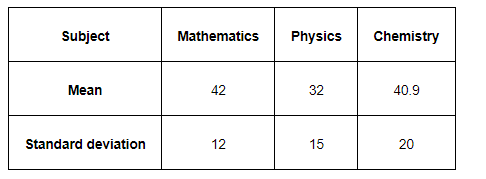The mean and standard deviation of marks obtained by 50 students of a class in three subjects, Mathematics, Physics and Chemistry are given below:

Which of the three subjects shows the highest variability in marks and which shows the lowest?
Standard deviation of Mathematics = 12
Standard deviation of Physics = 15
Standard deviation of Chemistry = 20
The coefficient of variation (C.V.) is given by $\frac{\text { Standard deviation }}{\text { Mean }} \times 100$.
C.V. (in Mathematics) $=\frac{12}{42} \times 100=28.57$
C.V. $($ in Physics $)=\frac{15}{32} \times 100=46.87$
C.V.(in Chemistry) $=\frac{20}{40.9} \times 100=48.89$
The subject with greater C.V. is more variable than others.
Therefore, the highest variability in marks is in Chemistry and the lowest variability in marks is in Mathematics.
Click here to get exam-ready with eSaral
For making your preparation journey smoother of JEE, NEET and Class 8 to 10, grab our app now.
